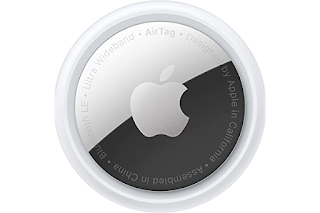Airtags - How they handle water ?
Apple AirTags have become a popular option for tracking personal belongings, helping users keep track of their essential items. However, like any technology, the question arises as to how these tiny tracking devices perform in various real life scenarios. A common concern is how Apple AirTags handle water challenges. So our question is "Are airtags waterproof ?
In this article, we'll discuss in detail the waterproofing characteristics of AirTags, their performance in wet conditions, and what to consider when using them near water.
Waterproofing Features of AirTags: Apple designed AirTags with a focus on durability and resistance to everyday environmental factors, including exposure to water.
The AirTag is rated with IP67 water and dust resistance, a standard commonly found in many modern smartphones and electronic devices. "IP" stands for Ingress Protection, and "67" represents two levels of protection:
1. Solid Particle Protection (6): The first digit indicates the level of protection against solid particles such as dust. A rating of "6" means the AirTag is completely dust-proof, protecting its internal components from fine particles.
2. Liquid ingress protection (7): The second digit indicates the device's resistance to liquid ingress. The "7" rating ensures that the AirTag can withstand submersion in up to 1 meter (about 3.3 feet) of water for up to 30 minutes without damage.
Performance in Wet Conditions
AirTags are designed to handle light exposure to water, such as splashes, rain, and minor submersion. This makes them suitable for tracking items that may occasionally encounter moisture during brief encounters with water, such as keys, wallets, bags, or even pet collars.
However, it is essential to understand the limitations of the IP67 rating. While AirTags can handle being submerged in shallow water for short periods of time, they are not meant for prolonged or deep water submersion. Exposing AirTags to excessive water pressure or underwater for extended periods of time can affect their waterproofing and damage internal components.
Best Practices for Water Use: To ensure optimal performance and longevity, here are some best practices when using AirTags near water:
1. Avoid deep water submersion: While the IP67 rating does provide some water resistance, it's best to avoid immersing AirTags in deep water or any situation where they may experience water pressure beyond the rating's limits Is.
2. Secure Attachment: Ensure AirTags are securely attached to items and that any accessories used (e.g., key rings, loops) also provide adequate water resistance.
3. Quick Dry: If an AirTag gets wet, dry it immediately with a soft cloth. Avoid using heat sources or applying direct heat to the AirTag, as this could potentially damage the device
4. Battery Maintenance: Check and replace batteries regularly to prevent leakage, which can compromise waterproofing over time.
Conclusion: Apple AirTags are engineered with waterproofing features to withstand the common water challenges faced in daily life.Their IP67 rating provides ample protection against splashes, rain, and brief submersion, making them suitable for most tracking scenarios involving water exposure. However, users should be mindful of the limitations of the IP67 rating and should avoid exposing the AirTags to extreme water conditions for long periods of time to ensure their longevity and reliable performance.

Comments
Post a Comment